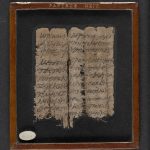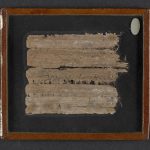| Artefact ID | 154 |
| TM ID | TM 32984 |
| Findspot (DEChriM ID) | 58 (Dayr al-ʿIẓām) | Class | Textual |
| Material | Papyrus |
| Writing medium | Sheet/roll |
| Text content | Documentary |
| Language | Greek |
| Archive/Dossier | Archive |
| Description | SB XVIII 13612; P. Lond. III 1014 descr.: Letter to Apa John. Fragmentary letter of the mother of the monk (apotaktikos) Philadelphos, a widow, with a request for help, presumably in relation to some matter involving a tax-collecting official (exactor). Docket on the back of the letter where it is described as a "request" (paraklesis). This request is one of many Greek and Coptic letters addressed by monks, clerics, soldiers, state officials and individuals to Apa John, so that he would intercede in their favour in dealings with the authorities or pray for them. The anchorite of this archive was identified with the famous John of Lycopolis known by literary sources by Zuckerman 1995. About SB XVIII 13612, Bagnall and Cribiore (2006: 209) note: "The text is correct in every respect and shows a good command of Greek. It presents a most unusual feature in a non-literary text: some punctuation marks. Together with the indications given by the hand, these facts point to the work of an accomplished writer". |
| Selection criteria | Mention of Christian individuals/communities, Christian terms/formulas/concepts |
| Date from | 375 |
| Date to | 399 |
| Dating criteria | Dated to 6th c. when mentioned as P.Lond. III 1014 descr., but redated by Parassoglou 1987 to 4th c. because of palaeography and mention of an exactor. Now connected to the archive of Apa John (Van Minnen 1994: 81, n. 54, and Zuckerman 1995: 188 n. 20, 190). |
| Absolute/relative date | Relative date |
| Archaeological context | According to C. Zuckerman's reconstruction, the Apa John’s letters were presumably found in September 1897, during the excavations of Farag Ismael and Yassa Tadros on the mountain of Siout (Lykopolis), in the ruins of Dayr al-'Azam, the site of the monastery of John of Lycopolis. Yet, they never reached the museum in Gizeh – like the other objects unearthed during these excavations – and must have ended on the market, where they were bought soon after the excavations (Zuckerman 1995: 189-192; Gonis 2008: 69-72). Although not proven, this attractive hypothesis is generally accepted by scholars (see discussion in Van der Vliet 2015: 166-167, some reservations in Choat 2017: 37-40). |
| Accession number | London, British Library, Pap 1014 |
ARTEFACT IDENTIFIERS
Editio princeps:
• Parássoglou, George M. 1987. "Request for Help." in Miscellània Papirològica Ramon Roca-Puig, ed. S. Janeras. Barcelona: Rafael Dalmau, 247-250, with pl.
Additional bibliography:
• Bagnall, Roger S. and Raphaella Cribiore. 2006. Women's Letters from Ancient Egypt, 300 BE–AD 800. Ann Arbor: The University of Michigan Press, 209.
• Choat, Malcolm and Maria Chiara Giorda. 2017. Writing and Communication in Early Monasticism. Texts and Studies in Eastern Christianity 9. Leiden, Boston.
• Gonis, Nikolaos. 2008. “Further Letters from the Archive of Apa Ioannes.” Bulletin of the American Society of Papyrologists 45, 69-85.
• Kenyon, Frederic G. and Harold I. Bell. 1907. Greek Papyri in the British Museum, vol. III. London, p. LII, no. 1014 descr.
• Van der Vliet, Jacques. 2015. “Snippets from the Past: Two ancient sites in the Asyut Region: Dayr al-Gabrawi and Dayr al-’Izam.” In Christianity and Monasticism in Middle Egypt, ed. Gawdat Gabra and Hany Takla. Cairo: The American University in Cairo Press, 161-168.
• Van Minnen, Peter. 1994. “The Roots of Egyptian Christianity.” Archiv für Papyrusforschung und verwandte Gebiete 41, 71-85.
• Wilcken, Ulrich. 1912. Grundzüge und Chrestomathie der Papyruskunde, I Bd. Historischer Teil, II Hälfte Chrestomathie. Leipzig-Berlin, 157, no. 130.
• Zuckerman, Constantine. 1995. "The Hapless Recruit Psois and the Mighty Anchorite, Apa John." Bulletin of the American Society of Papyrologists 32, 183-194.


 Json data
Json data





